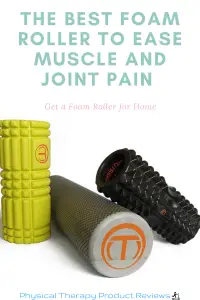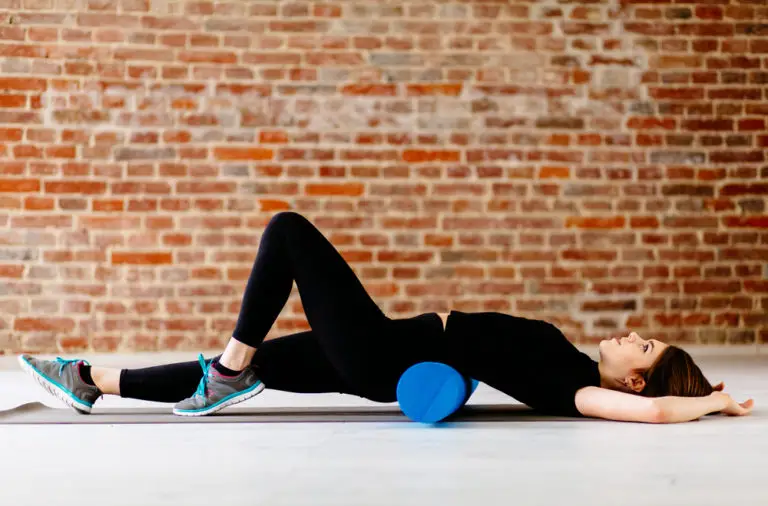Foam Roller Exercises for Low Back Pain
 Young or old, fit or not, low back pain is a common ailment for all types of people. Sometimes lower back pain can be chronic, other times it can last just a few hours. No matter the type of pain, you don’t need to helplessly bear it. Foam rollers are great at preventing a sore lower back as well as for easing the pain.
Young or old, fit or not, low back pain is a common ailment for all types of people. Sometimes lower back pain can be chronic, other times it can last just a few hours. No matter the type of pain, you don’t need to helplessly bear it. Foam rollers are great at preventing a sore lower back as well as for easing the pain.
What is a Foam Roller
A foam roller is a cylinder of compressed foam designed to ease muscle tension. This can be used on calves, shoulders, IT Band, and the back. A Harvard Health article points out – not all foam rollers are created equal. There are various types of rollers and they are color-coded to tell you the density. They range from white (softest) to black (most dense, or hardest). The denser the roller, the more intense pressure will be applied to your muscles.
Common Causes of Low Back Pain
Lower back pain can occur from doing a variety of tasks such as: running, lifting heavy objects, and even standing or sitting for long hours with poor posture. The pain can range from minimal to intensely debilitating. According to John Hopkins Medicine sometimes the pain can travel as far up as your neck or down one or both legs. Consequently, these pains have a starting point in the lower back, but if left unchecked or seriously injured, the pain will travel to other connected muscles. Common causes of low back pain include:
- Disc herniations and injuries
- Muscle strains
- Facet Irritation
- Osteoarthritis
- Pinched nerves and Radicular symptoms
- Stenosis and Narrowing of nerve pathways
Do you need a foam roller? See our reviews of the best foam rollers to help with muscle and joint pain
Benefits of Foam Rolling for Low Back Pain
Fight back and calm this pain easily, in the comfort of your own home! Foam Rolling is:
- Low cost
- Easy for any age/body type
- Convenient
- Fast
- Effective
- Usable for small and large muscle groups
- Relaxing and de-stressing
- Various Densities for your specific needs
The Best Foam Roller Exercises for Low Back Pain
These exercises work your glutes, shoulders and hip flexors to help release tension in your lower back and help you self manage your pain.
Foam Roll the Glutes and Back of the Hips
On a mat, or carpeted surface, place the foam roller on the ground and sit on it, in the center of the roller. Balance yourself and place your right hand behind you and your right ankle on your left knee. Your left knee should be at a 45-60 degree angle. Slowly roll up and down from your upper thigh to mid-way up your seat. The goal of this exercise is to stretch your glutes and lower back muscles. This increases hip mobility and movement preventing straining of your lower back muscles. Do this for 30-60 seconds on each side.
Foam Roll the Thoracic Spine
Place the roller under your upper back. Lift up your hips so that only your feet are touching the ground and your shoulders are on the roller. Roll back and forth slowly by straightening and bending your legs while supporting your neck and head with your hands. Do this for up to 2 minutes, but no more. The goal is to relax your upper back and ease the tension in your shoulder muscles. It will feel just like a massage and you may even get some nice pops that will help loosen up the back!
Foam Roll the Hip Flexors and Front of the Thigh
Hip flexors get tight from being used often, this exercise is key to keeping your hip flexors loose and in turn, your lower back relaxed. Start on your knees, with the foam roller in front of you. Place your hands in front of the foam roller and drop to your forearms, almost as if you are doing a plank over the foam roller. Place the top of your right thigh, near your pelvis, on the foam roller and bring your left knee up to the side of the roller so it’s bent at a 90 angle. Lift your right knee up so you are leaning on your toes and pelvis on the right side, and roll forward and back to applying pressure to the muscle just below your pelvis. Find any tension spots there and roll them as needed for 30-60 seconds. Switch sides and repeat for the same amount of time.
Bridges on the Foam Roller To Strengthen the Back
To make a stretch out of this exercise, lay on your back a mat, or soft surface. Bring your feet under your knees and lift your hips up. Place the roller underneath your tailbone – this is not on your lumbar (lower) spine, but rather the triangle area of your tailbone. Press down through your shoulder blades into the mat. Let the tailbone be fully supported by the roller. You can bring your knees together and your feet out slightly to stretch your lower back slightly more.
Foam Roller Open The Book Spine Rotation
Lay on your right side with your right leg straight and your left (top) leg bent to 90 degrees on the foam roller. Your knee should be a the top of the roller with your foot in about the center (this way it will not get in the way of your hands). Extend your right arm out in front of you on the ground. Reach your left arm up and across your body toward the floor on the opposite side, while keeping your right arm on the ground. Open and close your arms, slowly allowing the tension in your back to release with each breath. Practice for 60 seconds then switch sides.
Foam Roller Dead Bug to Work the Core Muscles
For anyone with low back pain it’s important to have a strong core and stomach muscles. It does not get any better than the the dead bug exercise which works the core muscles extensively. This is much harder than it looks. To start the exercise, get into the 90/90 position with your hips and knees bent to 90 degrees. Hold the foam roller between the knees and the arms. Really tighten the muscles of the stomach by doing and abdominal draw in maneuver. The goal of this exercise to PREVENT the spine from moving and to maintain it in place while the arms and legs move. DO NOT LET THE BACK ARCH or this count cause more pain. From the starting position slowly lower one leg towards the floor without changing positions. Bring the leg back up and do it again on the other leg.
Foam Roll the Hamstring Muscles
Start by placing the foam roller underneath your knees and hands in line with shoulders. Lift yourself up and roll the roller halfway up your thigh. Roll between your knees and halfway up your thighs for a maximum of 2 minutes. Then, roll from halfway up your thighs to the bottom of your seat. Again, practice for a maximum of 2 minutes.
Conclusion
Lower back pain can result from tight muscles in your hip flexors, glutes, and upper back. Using a foam roller has all sorts of benefits for releasing tension in these areas along with decreasing stress held by your muscles. Happy Rolling!
Works Cited
John Hopkins Medicine https://www.hopkinsmedicine.org/health/conditions-and-diseases/back-pain
Harvard Health https://www.health.harvard.edu/staying-healthy/roll-away-muscle-pain
Simple Stretches https://www.youtube.com/watch?v=QAV9T4eBLno
15 min Foam Roller Tutorial https://www.youtube.com/watch?v=H7wSCpnbfB4
Disclaimer: The information provided in this post is for educational purposes only. This is not a substitute for a medical appointment. Please refer to your physician before starting any exercise program.


